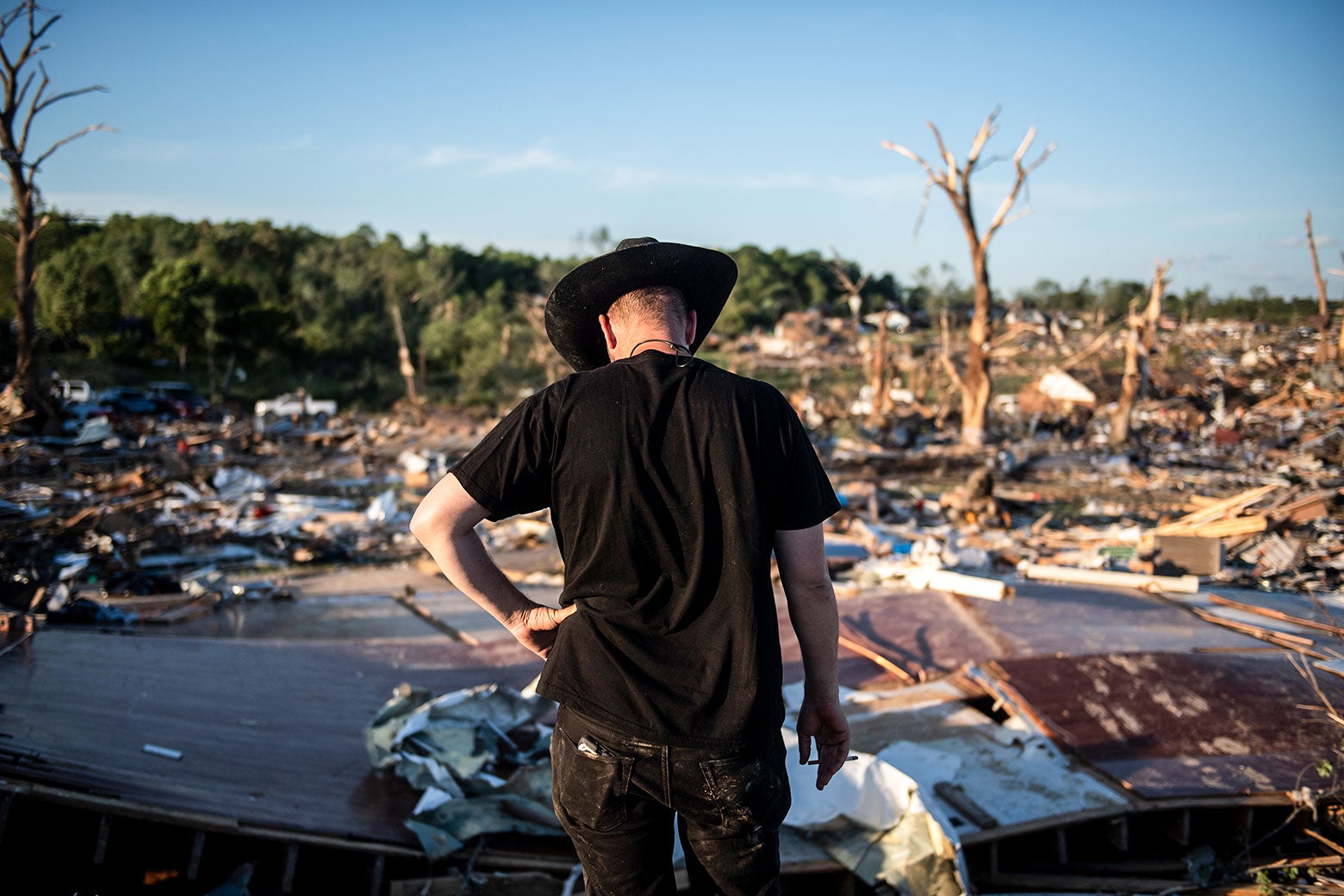Thousands are facing extreme weather with no help on the way.
By
Nitish Pahwa
Enter your email to receive alerts for this author.
Sign in or create an account to better manage your email preferences.
Are you sure you want to unsubscribe from email alerts for Nitish Pahwa?
Unsubscribe from email alerts
May 22, 20253:57 PM

Sign up for the Slatest to get the most insightful analysis, criticism, and advice out there, delivered to your inbox daily.
The weather has been just horrific lately throughout the United States. Last week, Chicago and El Paso were hit with the worst dust storms they’ve seen since the literal Dust Bowl. Over the weekend, states across the Midwest and the South were slammed by at least 100 tornadoes, all followed by baseball-size hail and pummeling rainstorms. The onslaught continued well into Tuesday, damaging thousands of homes and buildings and parks across a trail of 11 states, from Indiana to Minnesota to Oklahoma to Alabama.
CNN Weather reports that 28 people in three states have died as a result. A nor’easter is now making its way over to the East Coast, with 50-mph gusts and inches of rainfall in store for New England. Over Memorial Day weekend, severe thunderstorms are once again projected to slam middle and southern states, stretching from Nebraska down to Texas and out to Florida.
And there may be little if any help arriving for the survivors, thanks to the Trump administration’s mass government layoffs.
On Tuesday, St. Louis’ mayor told multiple news outlets that the Federal Emergency Management Agency had provided no ground support following the city’s billion-dollar tornado disaster—despite direct requests from Missouri Sen. Josh Hawley and the state’s Republican governor. (A few FEMA teams belatedly showed up on Wednesday, although Missouri has not yet been approved for emergency services.) In Kentucky, the agency’s response was also delayed, and recovery further complicated by outages to Louisville’s NOAA Weather Radio transmitters—because they were undergoing much-needed upgrades while storms were still racking the area. The National Weather Service outpost in Jackson, already so understaffed that it no longer operates 24/7, was forced to call in all of its meteorologists overnight to monitor the situation and blast out severe-weather updates. In Kansas, the NWS outfit in Goodland cut its own operating hours just a couple of days before the tornadoes landed. Galveston, Texas, which lies in the storm path, may face extra peril thanks to its broken NOAA radio (which hasn’t been fixed since it got knocked out by a fire in March) and an NWS forecasting office with a 44 percent vacancy rate.
These Americans are pulling themselves through a painful postdisaster recovery on the eve of hurricane season; others have been doing so for months and are still waiting for federal assistance. In mid-March, Mississippi was hit by 20 tornadoes that killed seven people and ruined hundreds of homes. But since President Donald Trump never approved a disaster declaration, several still-displaced Mississippians have received no help. Those March tornadoes also hit many of the same states suffering now, like Missouri and Oklahoma. Arkansas asked for federal emergency approval after those March storms, only to be denied at first; the state government appealed and finally got approved for disaster assistance last week, pushing FEMA to add face-to-face assistance sites across the Natural State.
These delays aren’t just red tape—they’re the result of a hollowed-out federal system. The Trump administration, with the help of anti-government hucksters affiliated with DOGE and Project 2025, has been slashing public-sector jobs so thoroughly that even the nation’s preeminent climate and disaster experts haven’t been spared. Back in February, DOGE’s rampage at the Department of the Interior led to 240 layoffs at the U.S. Geological Survey, an agency that monitors and studies large-scale natural disasters. That same month, the government fired members of the National Science Foundation—whose research has helped improve our weather systems—and axed 800 positions at the already inadequately staffed NOAA. Those funding shortfalls have cut into key NWS operations, like its forecast-modeling weather balloons, Doppler radars, and emergency-translation services (the latter of which were later restored). Earlier this month, the NWS put out a hiring call for dozens of meteorologists and staffers to fill in vacant positions at its field offices, including permanent meteorologists-in-charge for the aforementioned Jackson and Goodland outposts.
As for FEMA, which resides under the Department of Homeland Security—nearly 2,000 employees have taken buyouts this year, meaning that the agency has been running at about four-fifths of its typical capacity. Earlier this month, a FEMA memo obtained by Wired indicated that the agency would stop sending agents to canvass door to door in disaster areas. A couple of weeks ago, DHS Secretary Kristi Noem fired the organization’s acting administrator—because he had the temerity to tell Congress that Trump’s idea of eliminating FEMA wholesale was probably not the best idea. His replacement, David Richardson, then scrapped FEMA’s long-term strategic plan and ordered an internal review of the agency’s capabilities. The explicit conclusion: “FEMA is not ready” for this year’s hurricane season, thanks to issues with “staffing and contracts,” as well as general demoralization from Trump and Noem’s disparagement of the agency. (Apparently, remaining staffers have so little respect for Richardson that they send memes to one another mocking the acting chief, per a report from Business Insider.)
If you thought these past few months of catastrophe would inspire the Trump administration to retool its approach, think again. Just this Wednesday, 16 of FEMA’s senior executives left the agency. Richardson is now stacking his executive team with DHS staffers who come from other departments—and have zero experience with natural disasters. Trump is also going through with a plan to slash hundreds of millions of dollars delegated to flood-prevention projects in Democratic-led states—and increase such funding to Republican-run states. On top of that, cuts to public-radio support will also leave even fewer channels for emergency communication in remote areas.
It’s all especially galling when you remember how the GOP responded to the disasters that hit the U.S. even before Trump’s inauguration: the nonsensical critiques of local and federal preparedness for January’s California wildfires; the conspiracy theory–fueled death threats aimed at firefighters, FEMA officers, and meteorologists in the wake of Hurricane Milton, demonstrably hobbling relief efforts; baseless claims from Trump and conservative media that Democrats had delayed aid to Republican-led districts and states in the aftermath of Hurricane Helene and instead prioritized immigrants. Such delegitimization of already-underresourced federal institutions has only made it easier for the Trump administration to scythe them further, even as the effects come to harm Trump-friendly states.
The long-term effects of this senseless sabotage will mean that as climate change ramps up the rate and severity of extreme disasters, we will be less able to prepare for them and to repair the damage. As Gabrielle Gurley muses in the American Prospect, the degradation of the U.S. government’s world-class public weather systems is a deliberate effort to have private companies pick up the slack—a task that will be impossible for them to achieve at the same scale. The profit motive would keep such firms away from remote, sparsely populated, low-tech communities that need public weather infrastructure the most, such as Kentucky’s Amish neighborhoods; it would also mean that these companies would charge for the costs of providing forecasts and information that the feds offer for free thanks to taxes.
We’re well on the way to a future of absolute weather uncertainty—no surety to forecasts, a weakened ability to transmit emergency alerts—that we’ll nevertheless have to pay for out of our own pockets. What other choice will we have, as climate disasters arrive with more frequency and the federal government makes them even more dangerous?
Sign up for Slate's evening newsletter.









 English (US) ·
English (US) ·